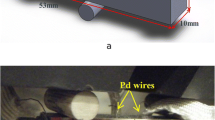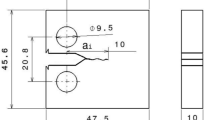Abstract
In this investigation, the growth behavior of a crack in a nickel-based superalloy under a turbine standard load sequence was determined by experimental, analytical, and computational methods. In the first experimental approach, ASTM standard compact tension (CT) test specimens were fabricated and fatigue crack growth (FCG) tests were conducted in a universal test machine under cold-TURBISTAN, a turbine standard spectrum load sequence. In the second analytical method, after rain-flow cycle counting of the cold-TURBISTAN sequence, the crack growth was estimated for each counted cycle from the crack growth law. The accumulated crack extension for each block of loading was thus estimated to determine the FCG behavior. In the third computational approach, a CT specimen containing an initial crack was modeled and the FCG behavior was predicted under cold-TURBISTAN spectrum load sequence using FRANC3D. The FCG trend predicted by analytical and computational methods was almost similar to the observed experimental behavior. The predicted FCG life was conservative with a life ratio ranging from 0.9 to 0.95.













Similar content being viewed by others
References
ASTM, E647-15e1 (2015) Standard test method for measurement of fatigue crack growth rates. Am Soc Test Mater PA. https://doi.org/10.1520/E0647-15E01
ASTM E1049–85 (2023) Standard practice for cycle counting in fatigue analysis. In: American Society for Testing and Materials PA. https://doi.org/10.1520/E1049-85R23
ASTM E08/E08M-22 (2024) Standard test methods for tension testing of metallic materials. Am Soc Test Mater PA. https://doi.org/10.1520/E0008_E0008M-22
ASTM E399-23 (2024) Standard test method for linear-elastic plane-strain fracture toughness of metallic materials. Am Soc Test Mater PA. https://doi.org/10.1520/E0399-23
Bhachu KS, Narasimhachary SB, Shinde S.R, Gravett PW (2017) Application of 3D fracture mechanics for improved crack growth predictions of gas turbine components. In: Turbo Expo: Power for Land, Sea, and Air (Vol. 50923, p. V07AT31A016). American Society of Mechanical Engineers
Caton MJ, John R, Porter WJ, Burba ME (2011) Stress ratio effects on small fatigue crack growth in Ti–6Al–4V. Int J Fatigue 38:36–45
Dahal J, Maciejewsk K, Ghonem H (2013) Loading frequency and microstructure interactions in intergranular fatigue crack growth in a disk Ni-based superalloy. Int J Fatigue 57:93–102
FRANC3D Version 7.5.1 (2024) Fracture Analysis Consultants, Inc (FAC), Cornell Fracture Group.
Jiang R, Bull DJ, Proprentner D, Shollock B, Reed PAS (2017) Effects of oxygen-related damage on dwell-fatigue crack propagation in a P/M Ni-based superalloy: From 2D to 3D assessment. Int J Fatigue 99:175–186
Li HY, Sun JF, Hardy MC, Evans HE, Williams SJ, Doel TJA, Bowen P (2015) Effects of microstructure on high temperature dwell fatigue crack growth in a coarse grain PM nickel based superalloy. Acta Mater 90:355–369
Malipatil SG, Majila AN, Chandru Fernando D, Manjunatha CM (2020) Influence of crack driving force on correlating stress ratio effects in fatigue crack growth rate of a nickel base superalloy IN720. Int J Adv Eng Sci Appl Math 12(1):19–26
Malipatil SG, Majila AN, Fernando DC, Manjuprasad M, Manjunatha CM (2021a) Fatigue crack growth behaviour of a nickel base super alloy GTM720 under cold-TURBISTAN spectrum load sequence. Theor Appl Fract Mech 112:102913
Malipatil SG, Majila AN, Fernando DC, Manjuprasad M, Manjunatha CM (2021b) Damage tolerance behaviour of a nickel-based super-alloy GTM718 under Cold-TURBISTAN variable amplitude loads. Trans Indian Inst Metals 74:901–907
SG Malipatil, N Majila, DC Fernando, M Manjuprasad, CM Manjunatha (2021c) A comparison of damage tolerance behaviour of two different nickel base superalloys under a turbine standard spectrum loads. Mater Today Proc 47(Part-14): 4897–4900.
Malipatil SG, Nagarajappa N, Majila AN, Fernando DC, Bojja R, Jagannathan N, Manjuprasad M, Manjunatha CM (2022) A study on the fatigue crack growth behaviour of GTM718 nickel based super alloy under cold-TURBISTAN spectrum loads. Theor Appl Fract Mech 120:103386
Mangardich D, Abrari F, Fawaz Z (2019) Modeling crack growth of an aircraft engine high pressure compressor blade under combined HCF and LCF loading. Eng Fract Mech 214:474–486
Manjunatha CM (2008) Fatigue crack growth prediction under spectrum load sequence in an aluminum alloy by K*-RMS approach. Int J Damage Mech 17(6):477–492
Manjunatha CM, Parida BK (2004) Prediction of fatigue crack growth after single overload in an aluminum alloy. AIAA J 42(8):1536–1542
Nagarajappa N, Malipatil SG, Majila AN, Fernando DC, Manjuprasad M, Manjunatha CM (2022) Fatigue crack growth prediction in nickel base superalloys under cold-TURBISTAN spectrum loads using FRANC3D. Trans Indian Natl Acad Eng 7(2):533–540
Newman Jr JC (1981) A crack-closure model for predicting fatigue crack growth under aircraft. In: Methods and models for predicting fatigue crack growth under random loading, 53–84
Newman JC (1996) Application of a closure model to predict crack growth in three engine disc materials. Int J Fract 80(2):193–218
Newman JC Jr, Kota K, Lacy TE (2018) Fatigue and crack-growth behavior in a titanium alloy under constant amplitude and spectrum loading. Eng Fract Mech 187:207–224
Onofrio G, Osinkolu GA, Marchionni M (2004) Effects of loading waveform on fatigue crack growth of Udimet 720 Li superalloy. Int J Fatigue 26(3):203–209
Padula Ii SA, Shyam A, Ritchi RO, Milligan WW (1999) High frequency fatigue crack propagation behavior of a nickel-base turbine disk alloy. Int J Fatigue 21(7):726–731
Ray A, Patankar R (2001) Fatigue crack growth under variable-amplitude loading: part II–Code development and model validation. Appl Math Model 25(11):995–1013
Remadi A, Bahloul C, Bouraoui A (2019) Prediction of fatigue crack growth life under variable-amplitude loading using finite element analysis. Comptes Rendus Mécanique 347(8):576–587
Stephens RR, Stephens RI, Veit AL, Albertson TP (1997) Fatigue crack growth of Ti-62222 titanium alloy under constant amplitude and miniTWIST flight spectra at 25° C and 175° C. Int J Fatigue 19(4):301–308
Storgärds E, Simonsson K, Sjöström S (2016) Three-dimensional crack growth modelling of a Ni-based superalloy at elevated temperature and sustained loading. Theoret Appl Fract Mech 81:2–10
Ten Have AA (1987) Cold Turbistan; final definition of a standarized fatigue test loading sequence for tactical aircraft cold section engine discs. NLR-TR 87054 L
Tvergaard V (2006) Effect of underloads or overloads in fatigue crack growth by crack-tip blunting. Eng Fract Mech 73(7):869–879
Wang Q, Wang X, Zhang N (2021) Investigation of the fatigue damage mechanism of Inconel 617 at elevated temperatures obtained by in situ SEM fatigue tests. Int J Fatigue 153:106518
Acknowledgements
The authors express their gratitude to the Directors of GTRE and CSIR-NAL for their support in conducting this study and permitting publication of the work. Thanks to the staff members of MEL, SID for their valuable assistance in conducting the experiments.
Author information
Authors and Affiliations
Contributions
Conceptualization and planning: CMM; Materials and testing: ANM,DCF; FEA: NN; Testing and analysis: SGM,RB.NJ; Manuscript preperation: SGM,RB,NJ,CMM; Review: MM, CMM.
Corresponding author
Ethics declarations
Competing interests
The authors declare no competing interests.
Conflict of interest
The authors declare no competing interests.
Additional information
Publisher's Note
Springer Nature remains neutral with regard to jurisdictional claims in published maps and institutional affiliations.
Rights and permissions
Springer Nature or its licensor (e.g. a society or other partner) holds exclusive rights to this article under a publishing agreement with the author(s) or other rightsholder(s); author self-archiving of the accepted manuscript version of this article is solely governed by the terms of such publishing agreement and applicable law.
About this article
Cite this article
Malipatil, S.G., Nagarajappa, N., Bojja, R. et al. Fatigue crack growth behavior of a nickel-based superalloy under turbine standard spectrum loads. Int J Fract (2024). https://doi.org/10.1007/s10704-024-00794-3
Received:
Accepted:
Published:
DOI: https://doi.org/10.1007/s10704-024-00794-3




